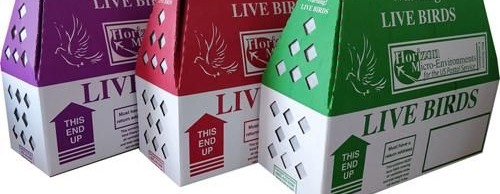
Shipping Live Birds
When shipping live birds we use great care to get them to their destination alive and in good health. We ship both juvenile to grown birds and younger chicks. Both often need to be in transit up to three days, so care is needed to make sure they stay fed and hydrated.
When chicks are being shipped, we use Flock-Lock boxes. They are made with a sturdier material we feel better protects the chicks in transit. As a shipper, what I like is the ability to put one side of the top down when I am filling it with chicks. Ventilation holes are strategically located so there are no worries about covering them up while taping. There is also a area of space on the top for the shipping label and they seal well for shipping. The creators of this box are chicken people so they really know what is needed for safely shipping chicks. We pay a little more for these boxes but feel our chicks are worth it. As a buyer getting what you have paid for is also worth it.
To ship larger birds we use boxes approved by the United States Postal Service for shipping live birds. They are made again, with sturdier materials to protect the birds during shipping. They are also lined with bio-filters that are required by the postal service. The box we use is made by Horizon and can be ordered with a divider to ship a pair of younger birds.
Before the chicks or birds go in the boxes, the boxes need some preparation for the trip. In the chick boxes we put down a ribbed corrugated shipping pad that allows the chicks to maintain sure footing during shipping. These pads also get rid of the mess of straw mats. These cardboard mats come with the boxes when you order them. In the larger Horizon boxes We put down brown paper from a shopping bag. I am never sure how much moisture goes through a box from the droppings so I add an additional layer.
To keep the birds hydrated we add grow-gel to the boxes for both the chicks and the larger birds. It provides a way to give the birds much needed water during their transport which is so important. In addition to grow-gel the larger birds get slices of cucumber or other fruits. The fruits are firm yet have nutrition and hydration. Because we use fruits that are firm they don't make a mess of the shipping box. For food, both groups get feed crumbles in the box. The idea is not to keep them well fed but to give them some nutrition along the way.
When the birds arrive at their destination they will be hungry. I would recommend giving feed a little at a time when they arrive so they do not over eat. It will be more important to get water and some electrolytes into the birds. You can get electrolytes in most feed stores for chicks. This can also be given to adult birds as well as fresh fruit that gives both hydration as well as calories with their sugar content. Gradually give more feed and settle your birds into their new homes.
Though shipping chicks and birds in the postal system sounds scary, most make it to their destination just fine. Because of their more delicate nature, the loss of chicks is a possibility. We do send a few extras to make sure our buyers get at least what was ordered.
We make sure any birds that leaves us is properly prepared to make their trip.We care about all our birds and do everything we can to make sure they arrive safe and sound to their new homes.



